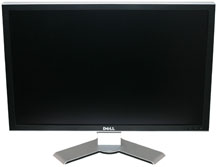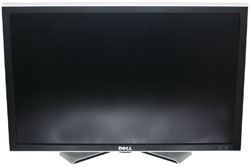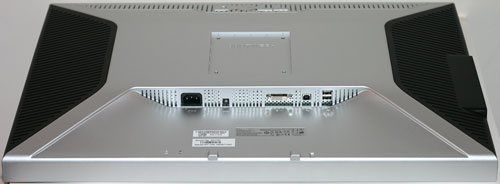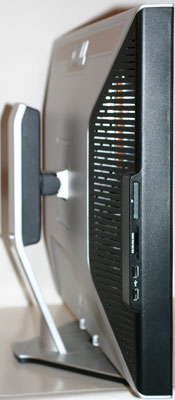Dell 2407WFP and 3007WFP LCD Comparison
by Jarred Walton on March 2, 2007 11:30 AM EST- Posted in
- Displays
Dell 3007WFP: Appearance and Design
The 3007WFP is almost a direct clone of the 2407WFP, at least in terms of the outward appearance. It's basically the big brother -- and we definitely mean BIG! Most users already think that a 24" LCD is pretty large, but the 2407WFP is absolutely dwarfed by the 3007WFP.
Other than the change in size, most of our commentary about the 2407WFP applies to the 3007WFP. It's attractive and it comes with a base stand that allows a reasonable amount of travel (about four inches).
You get tilt, swivel, and height adjustment courtesy of the base stand. If you prefer, you can also remove the base stand and use a standard 100mm VESA wall mount. Unlike the 2407WFP, there's no ability to rotate the display. Considering the size of the panel, that is to be expected -- you would need a base stand with about six inches of vertical travel to even be able to accommodate the increased height of portrait mode.
The rear of the display is relatively nondescript, but all of the connection ports are facing downwards so they aren't immediately visible.
As far as input ports go, as mentioned earlier only a single DVI port is present and the display requires a dual-link capable graphics card in order to run at its native 2560x1600 resolution. The 3007WFP can still function as a USB hub, and the USB input as well as two USB ports are located on the back of the display. Besides the main power connection, a power socket for an optional speaker bar is once again present.
Like the 2405FPW and 2407WFP, the left side provides two additional USB ports along with a flash memory reader. The same flash memory types as the 2407WFP are supported via the 9-in-2 reader.
Describing the On-Screen Display for the 3007WFP is extremely simple: there is no OSD! At the bottom of the display are three buttons: power, increase brightness, and decrease brightness. There are 20 levels of backlight intensity, but there's no immediate indication of your current setting. This is definitely taking minimalism to an extreme, and while many of the other features usually present in an OSD are unnecessary considering there is only one video input available, we really would have liked to see at least a few more options.
Speaking of options, we would also really like to see more video input choices. Granted, no analog signals are going to be capable of driving 2560x1600 resolution without experiencing signal degradation, but the 3007WFP does a good job at scaling non-native resolutions so it still should have been possible to include a VGA connection as well as component inputs and simply limit the maximum resolution with those connections to 1920x1200. We would also really like to be able to run single-link DVI at resolutions above 1280x800.
As it stands, the 3007WFP is intended pretty much only for use with a computer. Considering a 30" LCD is larger than a lot of people's televisions, it seems a shame to limit the versatility of the display.
30 Inch vs. 24 Inch
Having used both of these LCDs for a while, we felt it might be useful to provide our impressions of the experience. We used 21" CRTs for a long time, but the upgrade to a 24" LCD still broght noticeably more screen area. Personally, I held out switching to LCDs due to concerns about refresh rates and pixel response times, but when I finally upgraded to a 24" LCD (the 2405FPW), I was extremely pleased with the result. Some people still have complaints about LCDs versus CRTs, but overall we feel the benefits far outweigh the negatives and all of us are more than happy using LCDs on a daily basis.
If a 24" LCD feels pretty large compared to a 21" CRT (despite the fact that it weighs about one third as much), a 30" LCD is absolutely huge. Provided your eyesight is good enough, you almost feel the need to sit back several feet further away from the computer. Of course, the native resolution is such that icons and text are actually slightly smaller than what they would be on a 24" LCD, and if you end up sitting close to the screen like most people a 30" LCD can almost feel too big.
Another potential problem with such large LCDs is that they can require a ton of graphics power in order to run games at their native resolution. A single fast graphics card like a Radeon X1900 XT is generally sufficient for running most modern games at 1920x1200, but until the launch of the GeForce 8800 series it simply wasn't practical to play most games at 2560x1600 without dual GPUs. Even if you've got the graphics horsepower, configuring some games to run at the native resolution can be a pain, although thankfully this is getting better with time.
24" LCDs are pretty expensive still, and 30" LCDs are even more so, so before going out and spending a lot of money on a large LCD you will definitely want to try one out in person. Provided you have the hardware, using a 30" LCD is a really enjoyable experience for gaming and multitasking, at least from our perspective. Not everyone feels that way, however, and considering the price we feel that the 22"-26" LCDs are currently the sweet spot. You could purchase two 24" LCDs for the price of a 30" LCD right now, and there are also plenty of desks where it simply isn't practical to try and use a 30" display. If you've got the money and desk space, however, a 30" LCD definitely won't disappoint -- it just might take a little time to get used to having such a huge monitor.
The 3007WFP is almost a direct clone of the 2407WFP, at least in terms of the outward appearance. It's basically the big brother -- and we definitely mean BIG! Most users already think that a 24" LCD is pretty large, but the 2407WFP is absolutely dwarfed by the 3007WFP.
 |
| Click to enlarge |
Other than the change in size, most of our commentary about the 2407WFP applies to the 3007WFP. It's attractive and it comes with a base stand that allows a reasonable amount of travel (about four inches).
 |
 |
| Click to enlarge | |
You get tilt, swivel, and height adjustment courtesy of the base stand. If you prefer, you can also remove the base stand and use a standard 100mm VESA wall mount. Unlike the 2407WFP, there's no ability to rotate the display. Considering the size of the panel, that is to be expected -- you would need a base stand with about six inches of vertical travel to even be able to accommodate the increased height of portrait mode.
 |
| Click to enlarge |
The rear of the display is relatively nondescript, but all of the connection ports are facing downwards so they aren't immediately visible.
 |
| Click to enlarge |
As far as input ports go, as mentioned earlier only a single DVI port is present and the display requires a dual-link capable graphics card in order to run at its native 2560x1600 resolution. The 3007WFP can still function as a USB hub, and the USB input as well as two USB ports are located on the back of the display. Besides the main power connection, a power socket for an optional speaker bar is once again present.
 |
| Click to enlarge |
Like the 2405FPW and 2407WFP, the left side provides two additional USB ports along with a flash memory reader. The same flash memory types as the 2407WFP are supported via the 9-in-2 reader.
Describing the On-Screen Display for the 3007WFP is extremely simple: there is no OSD! At the bottom of the display are three buttons: power, increase brightness, and decrease brightness. There are 20 levels of backlight intensity, but there's no immediate indication of your current setting. This is definitely taking minimalism to an extreme, and while many of the other features usually present in an OSD are unnecessary considering there is only one video input available, we really would have liked to see at least a few more options.
Speaking of options, we would also really like to see more video input choices. Granted, no analog signals are going to be capable of driving 2560x1600 resolution without experiencing signal degradation, but the 3007WFP does a good job at scaling non-native resolutions so it still should have been possible to include a VGA connection as well as component inputs and simply limit the maximum resolution with those connections to 1920x1200. We would also really like to be able to run single-link DVI at resolutions above 1280x800.
As it stands, the 3007WFP is intended pretty much only for use with a computer. Considering a 30" LCD is larger than a lot of people's televisions, it seems a shame to limit the versatility of the display.
30 Inch vs. 24 Inch
Having used both of these LCDs for a while, we felt it might be useful to provide our impressions of the experience. We used 21" CRTs for a long time, but the upgrade to a 24" LCD still broght noticeably more screen area. Personally, I held out switching to LCDs due to concerns about refresh rates and pixel response times, but when I finally upgraded to a 24" LCD (the 2405FPW), I was extremely pleased with the result. Some people still have complaints about LCDs versus CRTs, but overall we feel the benefits far outweigh the negatives and all of us are more than happy using LCDs on a daily basis.
If a 24" LCD feels pretty large compared to a 21" CRT (despite the fact that it weighs about one third as much), a 30" LCD is absolutely huge. Provided your eyesight is good enough, you almost feel the need to sit back several feet further away from the computer. Of course, the native resolution is such that icons and text are actually slightly smaller than what they would be on a 24" LCD, and if you end up sitting close to the screen like most people a 30" LCD can almost feel too big.
Another potential problem with such large LCDs is that they can require a ton of graphics power in order to run games at their native resolution. A single fast graphics card like a Radeon X1900 XT is generally sufficient for running most modern games at 1920x1200, but until the launch of the GeForce 8800 series it simply wasn't practical to play most games at 2560x1600 without dual GPUs. Even if you've got the graphics horsepower, configuring some games to run at the native resolution can be a pain, although thankfully this is getting better with time.
24" LCDs are pretty expensive still, and 30" LCDs are even more so, so before going out and spending a lot of money on a large LCD you will definitely want to try one out in person. Provided you have the hardware, using a 30" LCD is a really enjoyable experience for gaming and multitasking, at least from our perspective. Not everyone feels that way, however, and considering the price we feel that the 22"-26" LCDs are currently the sweet spot. You could purchase two 24" LCDs for the price of a 30" LCD right now, and there are also plenty of desks where it simply isn't practical to try and use a 30" display. If you've got the money and desk space, however, a 30" LCD definitely won't disappoint -- it just might take a little time to get used to having such a huge monitor.










62 Comments
View All Comments
Zebo - Friday, March 2, 2007 - link
The HC is still IPS and even better this time covering 93% of adobe color gamet vs 72% past model and it's more overdriven making it faster. Inputs are still lame with DVI only.Right now only corp customers can get the HC.
There is a non technical review floating around the net with nice pics..hot hardware I think.
acivick - Friday, March 2, 2007 - link
As nice as these monitors are, it seems to be that no one is really releasing any new 4:3 or 5:4 monitors anymore. Everything is widescreen. Sure, I think it's great when you're watching movies, but that's why I have a widescreen TV.I primarily use my PC for office work and games, neither of which really lend themselves to widescreen very well. Maybe a lot of newer games are coming out with widescreen support, but a good number don't offer it, at least officially.
Maybe I'm just a minority now, since every company seems to be focusing on it. Anyone else with similar opinions?
JarredWalton - Friday, March 2, 2007 - link
I definitely prefer WS displays, even outside of gaming. The ability to easily put two full pages of text next to each other is nice, and it's one of the reasons I don't find portrait mode on larger WS LCDs to be useful. I just wish more games were properly (i.e. natively with proper aspect ratio) supporting widescreen modes. On smaller displays, however, I'm not as big a fan of WS - I'd prefer a 19/20" standard AR over a 19/20" WS display. Basically, if you can't get at least 1680x1050 I'd just as soon stick with a normal AR.yyrkoon - Friday, March 2, 2007 - link
Personally, I think it would be good to include power usage of LCD monitors you're testing. I know you guys have the equipment already, and this is one of a few reasons why people use LCD vs CRT. Is this information in the article aready ? IF so, I missed it . . .mongo lloyd - Saturday, March 3, 2007 - link
Lower power consumption with LCDs is mostly a myth nowadays when you're moving up to the bigger and/or brighter monitors. As you can see with the specs here, both these monitors eat as much as (in the case of the 24") and more power than (in the case of the 30") a 21-22" CRT (most commonly ~125 W). The few business-oriented CRTs that are still available usually draw around 75-85 W, which many LCDs do as well.So that "benefit with LCD monitors" is also questionable...
JarredWalton - Friday, March 2, 2007 - link
It's listed on the specs tables, although those are manufacturer figures. They're generally accurate, however, with a pure white output using more power than a black output. I'll see about adding a quick test of min/max/avg power use on future reviews, though - thanks for the suggestion.tmok2007 - Friday, March 2, 2007 - link
Sorry, the 3007WFP is selling for $1,350. Where can I find a 37" or 42" 1080p LCD TV for less than this?timmiser - Friday, March 2, 2007 - link
The Westinghouse 37" model is available at Newegg for $999.JarredWalton - Friday, March 2, 2007 - link
Check Google/Froogle: Westinghouse makes a 1080p 42" that starts at around $1300, and the 37" is slightly less IIRC.exdeath - Friday, March 2, 2007 - link
Could we add the 2707WFP in there?Its a 27" compromise between the wider range of capabilities of the 30" and the smaller size of the 24"
Single link 1920x1200 with a built in scaler (and thus multiple inputs) but larger than the 24". 1920x1200 is also more manageable for gaming, as even with 8800 SLI some games just can't run fast and smooth enough at 2560x1600.
As for the .303mm pixel pitch, keep in mind that a 19" 4:3 1280x1024 screen that I would wager is the most common LCD in use right now is like .295mm and I never heard anyone complaining about the 19" displays... I think breaking the .3xx barrier is more of a psychological effect of seeing a "3" in the dot pitch spec more than anyone being truly disturbed by perceived graininess. Also, the 37" and 42" screens people love for their HDTVs are like .85mm pitch...
Anyone, could you maybe update later with the 2707WFP as well? I'm considering getting one, and the metal and glass trim would go well with my ATC111 and glass desk :)